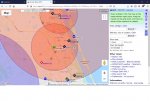I'd use something other than an inexpensive radio with questionable filtering.
I'd also suggest using a dedicated iGate/digipeater rather than a Mobilinkd and software, though that would be doable.
Let's start with the radio. A high-profile digipeater is going to be bombarded with lots of RF and it is also probably going to be transmitting a lot. You need a robust radio that has sufficient front-end filtering to deal with the off-frequency RF. And, you need a robust radio that can deal with being keyed down a lot. If your planned digipeater is at a lower profile, you can back off these requirements a bit. I'd suggest scouring the used market for a Kenwood TK-790 or TK-7180. I'd also suggest a Motorola mobile radio, but I'm not as familiar with them. I know of one high-profile digi (the antenna is at about 480 feet AGL) that uses a Motorola, I think it's a CDM-1250, with very good performance. If you are talking about a lower profile digi, a Yaesu FT-2600 or Alinco DR-135T would work and be easy to interface with.
The second thing you need is a TNC. A lot of hams don't understand what a TNC does, so let's review. A TNC has two functions: 1. modulate and demodulate the audio to/from the radio, 2. construct and deconstruct the packets and interface with the world usually over a serial connection. In the old days, the mod/demod function was done by a Bell 202 modem (remember, we are talking about 1200 bits/second AFSK here), but more modern TNCs do the mod/demod in firmware running on some sort of small-scale CPU. With any TNC, audio from the radio goes in the radio port, the audio is demodulated, the packets are examined to make sure they are intact (CRC check), and serial data comes out the serial port. The transmit path is just the reverse.
I do not recommend the Signalink for packet radio, though it will work. It is not a TNC. It's merely a sound card interface between your radio and your computer. The TNC functions would have to be done in software. Yes, lots of people make this work with sound card TNCs like AGW or Direwolf, but, in my experience, the settings can be a little fiddly.
So, what TNCs are available. The old standby and still a workhorse in the packet radio world is the Kantronics KPC3 or KPC3+. They are expensive new, but you can buy used ones for less than $100. With a KPC3, you connect the radio (Tx audio, Rx audio, PTT, and ground) to the radio port and a computer to the serial port (usually RS-232 on older TNCs). Note that later KPC3 models with the APRS firmware can be configured as digipeaters. It's all done in hardware/firmware with no need for an external computer. Aside from the KPC3, the Argent Data Tracker 4, Byonics TinyTrak4, and the Mobilinkd are also capable TNCs with APRS functions including digipeaters.
An Igate is going to require a computer to interface between the TNC and the Internet. In the Windows PC world, UI-View32 and APRSISCE/32 are software that can be configured as digipeaters. In the Linux world, I think Xastir or BPQ32 are the primary candidates.
For a Raspberry Pi, you can use an external TNC and run either BPQ32 or Xastir. BPQ32 has a steep learning curve, but it's very flexible. When Coastal Chipworks was still in operation, they produced the TNC Pi which was a TNC in Pi daughterboard. I have a couple of these and they work very well with BPQ32 running on the Pi.
Another option is an all-in-one TNC/digipeater/Igate. Take a look at the
Microsat WX3in1 as it has everything built into one box. No computer or external software needed. Just add a radio.



